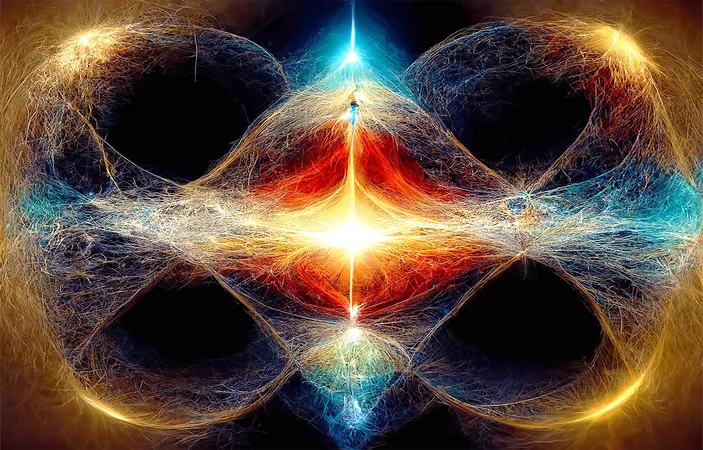
Is Everything Alive? The Fascinating Theory of Panpsychism Gaining Traction
2025-05-17
Author: Nur
Could Every Atom Have a Consciousness?
Consciousness has long been viewed as a uniquely human trait, firmly rooted in our brains and behavior. However, a provocative idea known as panpsychism is stirring debate in both scientific and philosophical circles, suggesting that every entity in the universe—be it animals, plants, or even atoms—could possess some form of consciousness.
The Rise of Panpsychism
Interest in panpsychism has surged as researchers grapple with what’s called the "hard problem of consciousness": the perplexing question of how physical matter can give rise to subjective experiences. This prompts us to wonder: If neurons alone can't explain consciousness, could it be that awareness is already everywhere, just waiting to be organized into sophisticated minds like ours?
A Historical Perspective on Consciousness
This idea isn’t entirely new; philosophers have pondered its implications for centuries. Ancient thinkers like Thales of Miletus speculated that objects, such as magnets, possess souls because they exhibit movement. Anaxagoras followed suit, claiming that everything holds a fragment of mind, while Greek Stoics regarded the universe itself as a living organism infused with a rational spirit.
Fast forward to the Renaissance; figures like Giordano Bruno envisioned a universe vibrant with conscious worlds. These ideas often grappled with the mechanistic views that dominated the scientific narrative, yet they have endured.
From Descartes to Modern Neuroscience
During the Enlightenment, René Descartes bifurcated mind and matter, relegating consciousness to an immaterial realm. In contrast, Gottfried Wilhelm Leibniz introduced "monads," indivisible units of perception reflecting the cosmos. By the late 19th century, thinkers like William James and Alfred North Whitehead suggested that consciousness might weave through the fabric of nature, evolving alongside life itself.
Today, neuroscientists are tackling consciousness with groundbreaking theories like Integrated Information Theory (IIT), proposed by Giulio Tononi in 2004. IIT posits that a system’s conscious experience correlates to the amount of integrated information it generates, measured by a value known as 'Φ'. Higher Φ signifies a richer experience. Remarkably, IIT implies that consciousness could emerge from many structures, including artificial networks and perhaps even simple materials.
What About Quantum Mechanics?
The link between quantum physics and consciousness has brought further intrigue to the panpsychism discussion. Notably, physicist Roger Penrose and anesthesiologist Stuart Hameroff’s Orch-OR theory suggests that consciousness emerges from quantum processes within neurons. Critics argue against the feasibility of sustained quantum states in warm, biological systems, yet supporters point to new findings that challenge this skepticism.
The Implications of Panpsychism
Some philosophers are wary of panpsychism, fearing that attributing consciousness to inanimate objects trivializes the concept of feeling. A key challenge remains the "combination problem": how do countless individual experiences coalesce into the unified consciousness we perceive? Despite these hurdles, panpsychism persists as a compelling solution to bridging the mind-matter divide.
The Future of Consciousness Research
As the quest for understanding consciousness evolves, advancements in experimentation and theory are crucial. Neuroscientists are honing Φ-based metrics, while physicists seek to uncover quantum signatures in nature. Philosophers continue to re-evaluate ancient ideas against modern logic, questioning whether panpsychism offers genuine insight or is merely a verbal trick.
Ultimately, this exploration invites us to reconsider consciousness not as a rarity but possibly a fundamental aspect of existence—a basic note in the cosmic symphony. This challenging notion may not ask us to endow rocks with minds but rather to decipher how simple elements contribute to the complex melody of life.



 Brasil (PT)
Brasil (PT)
 Canada (EN)
Canada (EN)
 Chile (ES)
Chile (ES)
 Česko (CS)
Česko (CS)
 대한민국 (KO)
대한민국 (KO)
 España (ES)
España (ES)
 France (FR)
France (FR)
 Hong Kong (EN)
Hong Kong (EN)
 Italia (IT)
Italia (IT)
 日本 (JA)
日本 (JA)
 Magyarország (HU)
Magyarország (HU)
 Norge (NO)
Norge (NO)
 Polska (PL)
Polska (PL)
 Schweiz (DE)
Schweiz (DE)
 Singapore (EN)
Singapore (EN)
 Sverige (SV)
Sverige (SV)
 Suomi (FI)
Suomi (FI)
 Türkiye (TR)
Türkiye (TR)
 الإمارات العربية المتحدة (AR)
الإمارات العربية المتحدة (AR)